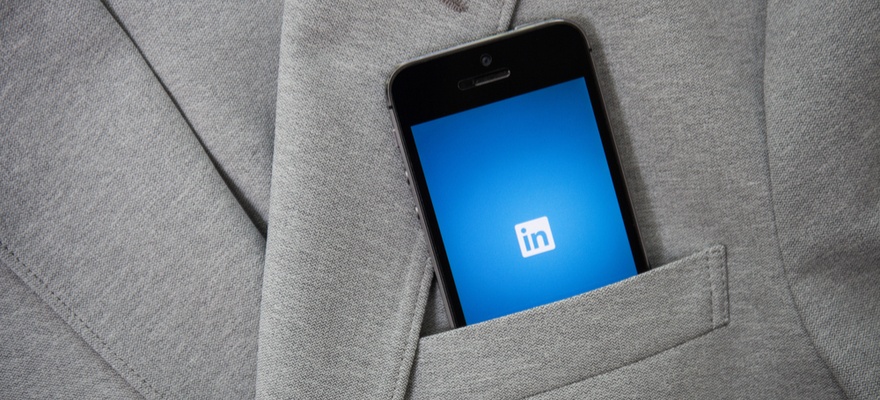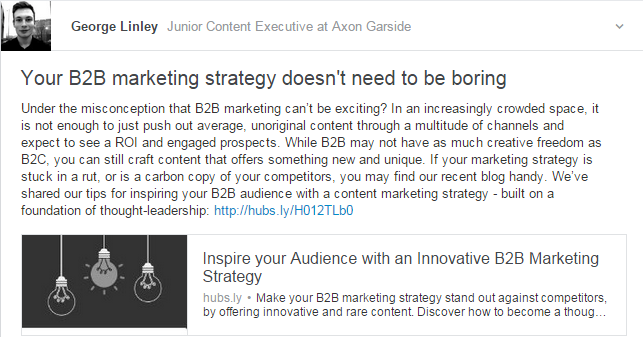Why B2B lead generation should begin with LinkedIn
What makes LinkedIn a vital part of B2B lead generation strategies? It is the BEST channel to engage directly with relevant prospects and decision-...

Are you under the impression that LinkedIn is only for jobseekers and recruiters and have very little to do with B2B lead generation? You may be surprised to learn that 65% of B2B companies have acquired a customer through LinkedIn. Furthermore, LinkedIn drives more traffic to B2B blogs and websites than any other social network.
Reach prospects
LinkedIn is serious business for every B2B organisation. While the likes of Twitter, Facebook and Pinterest blur the lines between personal interactions and business opportunities, LinkedIn is through and through a professional network. In fact, one third of all working professionals are on LinkedIn!
So, what makes LinkedIn a vital part of B2B lead generation strategies? It is simply the best channel to engage directly with relevant prospects and decision-makers within your target audience. These prospects are also very active. While on LinkedIn, 74% of users research people and companies, while six out of ten come to the social network for industry insights.
So, you have a relevant audience, itching for your company’s expertise and insights. It’s time to engage with them!
Get the most out of your personal profile
A LinkedIn personal profile is essentially an online CV, offering a space to showcase your work experience, skills and authority level. It is definitely worth giving your personal profile attention and care, considering that 25 million profiles are viewed daily. When posting content and engaging with prospects, a detailed profile will give what you say extra weight and authority, backed up by your industry experience and job role.
Engage in groups
LinkedIn groups are essentially live forums for like-minded individuals to discuss specific industry topics, start conversations and ask for advice. Therefore, they are the perfect platform to reach relevant prospects on a large scale.
First things first, identify relevant groups for you to join. These groups need to be related to your job title, industry and most importantly, your prospects. For example, as a content executive, groups that discuss content marketing are both relevant to my industry and work experience, while likely to include prospects to engage with.
For me, Content Marketing Institute is an ideal group to join. It is an ideal space for me to share advice and content marketing insights, while reaching out to potential prospects who are considering outsourcing their content marketing to an agency.

When posting in groups, the principles of inbound marketing still apply. The purpose of LinkedIn group marketing is to attract potential prospects who are in the awareness stage of the buyer’s journey. Therefore, refrain from being overly promotional. LinkedIn and group administrators penalise promotional posts, which can result in you being removed from a group. Instead, share educational blog posts that expand further on a relevant prospect problem. Open questions and problem-solution formats should be used to intrigue prospects and encourage them to click through to your promoted blog posts.

Groups, however, are a two-way street. Don’t expect to see a substantial amount of traffic and post engagements if you fail to contribute on other members’ posts. Comment on other posts, offering alternative views, advice or questions. Group members will appreciate your contributions and will therefore be more receptive to your own content.
Initiate personalisation with InMails
Getting through to decision-makers and directors is notoriously difficult. They are often overwhelmed by numerous sales calls and emails on a day by day basis, so engaging with these prospects can be an uphill battle. This is why InMail is so useful. If you have a paid account, you can send InMails to any person, without an introduction from a mutual contact. Furthermore, InMails are 30 times more likely to get a response than cold calling.
As you only receive three InMail credits per month, you need to make them count. As a benchmark, InMails need to be personalised and highlight the fact that you’ve taken the time to research your recipient. Also, don’t make assumptions. Your recipient is unlikely to take the time to hover over to your profile to find out who you are – make this clear in your opening line. Most importantly, get to the point of your InMail and fast. People have limited time on their hands and will lose interest if your intent isn’t immediately clear.
Don’t forget about your company page
Although personal profiles are an excellent platform for kick-starting the lead generation process, they can’t replace the professionalism and authenticity of an established company page. Unsure why you need one? 94% of B2B companies, i.e. your competitors are on LinkedIn. Furthermore, LinkedIn company pages are directly linked to your personal profiles. When a potential prospect visits your profile, they can click on to the company you work for. Once directed, if the company page is of poor quality, or even worse, doesn’t exist, then this can reflect badly on you and your organisation. Having no company page in place damages your company’s professionalism, while making it more difficult for prospects to trust in your personal expertise.
This blog was originally published in August 2015 and has been updated where possible for accuracy and comprehensiveness in June 2017.
 George Linley
George Linley
